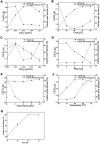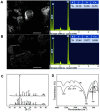Improvement of Biomineralization of Sporosarcina pasteurii as Biocementing Material for Concrete Repair by Atmospheric and Room Temperature Plasma Mutagenesis and Response Surface Methodology
- PMID: 34319256
- PMCID: PMC9705896
- DOI: 10.4014/jmb.2104.04019
Improvement of Biomineralization of Sporosarcina pasteurii as Biocementing Material for Concrete Repair by Atmospheric and Room Temperature Plasma Mutagenesis and Response Surface Methodology
Abstract
Microbially induced calcium carbonate precipitation (MICP) has recently become an intelligent and environmentally friendly method for repairing cracks in concrete. To improve on this ability of microbial materials concrete repair, we applied random mutagenesis and optimization of mineralization conditions to improve the quantity and crystal form of microbially precipitated calcium carbonate. Sporosarcina pasteurii ATCC 11859 was used as the starting strain to obtain the mutant with high urease activity by atmospheric and room temperature plasma (ARTP) mutagenesis. Next, we investigated the optimal biomineralization conditions and precipitation crystal form using Plackett-Burman experimental design and response surface methodology (RSM). Biomineralization with 0.73 mol/l calcium chloride, 45 g/l urea, reaction temperature of 45°C, and reaction time of 22 h, significantly increased the amount of precipitated calcium carbonate, which was deposited in the form of calcite crystals. Finally, the repair of concrete using the optimized biomineralization process was evaluated. A comparison of water absorption and adhesion of concrete specimens before and after repairs showed that concrete cracks and surface defects could be efficiently repaired. This study provides a new method to engineer biocementing material for concrete repair.
Keywords: Biomineralization; calcite; calcium carbonate; concrete repair; optimization.
Conflict of interest statement
The authors have no financial conflicts of interest to declare.
Figures






Similar articles
-
Beneficial factors for biomineralization by ureolytic bacterium Sporosarcina pasteurii.Microb Cell Fact. 2020 Jan 23;19(1):12. doi: 10.1186/s12934-020-1281-z. Microb Cell Fact. 2020. PMID: 31973723 Free PMC article.
-
Calcium Carbonate Precipitation by Bacillus and Sporosarcina Strains Isolated from Concrete and Analysis of the Bacterial Community of Concrete.J Microbiol Biotechnol. 2016 Mar;26(3):540-8. doi: 10.4014/jmb.1511.11008. J Microbiol Biotechnol. 2016. PMID: 26699752
-
Optimization of growth medium for Sporosarcina pasteurii in bio-based cement pastes to mitigate delay in hydration kinetics.J Ind Microbiol Biotechnol. 2016 Apr;43(4):567-75. doi: 10.1007/s10295-015-1726-2. Epub 2016 Jan 21. J Ind Microbiol Biotechnol. 2016. PMID: 26795346
-
Microbially Induced Calcium Carbonate Precipitation by Sporosarcina pasteurii: a Case Study in Optimizing Biological CaCO3 Precipitation.Appl Environ Microbiol. 2023 Aug 30;89(8):e0179422. doi: 10.1128/aem.01794-22. Epub 2023 Jul 13. Appl Environ Microbiol. 2023. PMID: 37439668 Free PMC article. Review.
-
Application of microorganisms in concrete: a promising sustainable strategy to improve concrete durability.Appl Microbiol Biotechnol. 2016 Apr;100(7):2993-3007. doi: 10.1007/s00253-016-7370-6. Epub 2016 Feb 20. Appl Microbiol Biotechnol. 2016. PMID: 26896159 Review.
Cited by
-
ARTP Mutagenesis of Phanerochaete chrysosporium BZ103 to Enhance Laccase Activity and Transcriptomic Analysis of the Mutants.J Microbiol Biotechnol. 2025 Jun 12;35:e2502014. doi: 10.4014/jmb.2502.02014. J Microbiol Biotechnol. 2025. PMID: 40537905 Free PMC article.
-
Adaptive Evolution of Sporosarcina pasteurii Enhances Saline-Alkali Resistance for High-Performance Concrete Crack Repair via MICP.Microorganisms. 2025 Jun 30;13(7):1526. doi: 10.3390/microorganisms13071526. Microorganisms. 2025. PMID: 40732037 Free PMC article.
-
Microbial Carbonate Mineralization: A Comprehensive Review of Mechanisms, Applications, and Recent Advancements.Mol Biotechnol. 2025 May 8. doi: 10.1007/s12033-025-01433-5. Online ahead of print. Mol Biotechnol. 2025. PMID: 40338440 Review.
-
Biomineralization Induced by Cells of Sporosarcina pasteurii: Mechanisms, Applications and Challenges.Microorganisms. 2021 Nov 21;9(11):2396. doi: 10.3390/microorganisms9112396. Microorganisms. 2021. PMID: 34835521 Free PMC article. Review.
-
Highlighting Bacteria with Calcifying Abilities Suitable to Improve Mortar Properties.Materials (Basel). 2022 Oct 17;15(20):7259. doi: 10.3390/ma15207259. Materials (Basel). 2022. PMID: 36295324 Free PMC article.
References
-
- Muynck WD, Cox K, Belie ND, Verstraete W. Bacterial carbonate precipitation as an alternative surface treatment for concrete. Constr. Build. Mater. 2008;22:875–885. doi: 10.1016/j.conbuildmat.2006.12.011. - DOI
-
- Pacheco-Torgala F, Labrincha JA. Biotech cementitious materials: Some aspects of an innovative approach for concrete with enhanced durability. Constr. Build. Mater. 2013;40:1136–1141. doi: 10.1016/j.conbuildmat.2012.09.080. - DOI
-
- Tait K, Sayer JA, Gharieb MM, Gadd GM. Fungal production of calcium oxalate in leaf litter microcosms. Soil Biol. Biochem. 1999;31:1189–1192. doi: 10.1016/S0038-0717(99)00008-5. - DOI
MeSH terms
Substances
Supplementary concepts
LinkOut - more resources
Full Text Sources
Molecular Biology Databases

